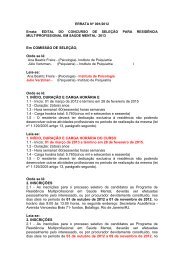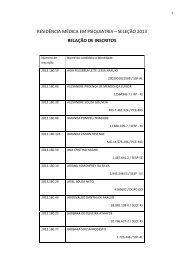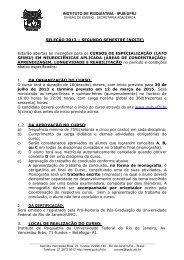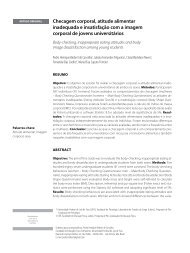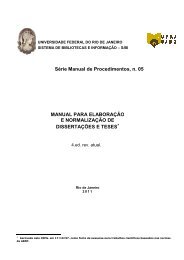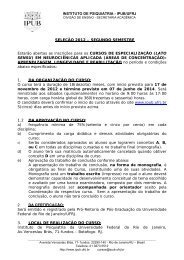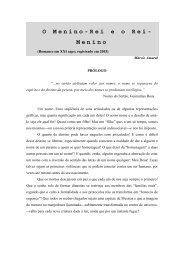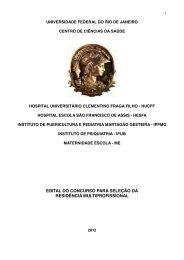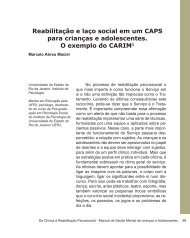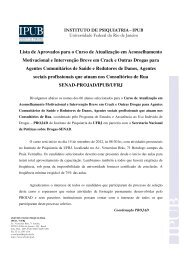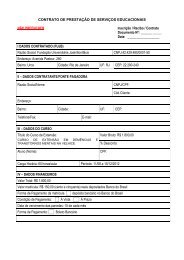Originais â Originals outubro | dezembro ⢠2011 - IPUB - UFRJ
Originais â Originals outubro | dezembro ⢠2011 - IPUB - UFRJ
Originais â Originals outubro | dezembro ⢠2011 - IPUB - UFRJ
You also want an ePaper? Increase the reach of your titles
YUMPU automatically turns print PDFs into web optimized ePapers that Google loves.
ORIGINAL ARTICLE<br />
Factors related to dissatisfaction in adolescents<br />
317<br />
International Physical Activity Questionnaire<br />
(IPAQ): The IPAQ was developed as an instrument for crossnational<br />
monitoring of physical activity and inactivity 15 . The<br />
Brazilian version of the questionnaire was validated for adolescents<br />
of both sexes by Guedes et al. 16 .<br />
The short version of the IPAQ assesses physical activity<br />
undertaken across a comprehensive set of domains including:<br />
leisure time physical activity; domestic and gardening (yard)<br />
activities, work-related physical activity, and transport-related<br />
physical activity, and asks about three specific types of activity<br />
undertaken in the above four domains. The specific types of<br />
activity assessed are walking, moderate-intensity activities<br />
and vigorous-intensity activities. The 3 items in the short<br />
IPAQ form were structured to provide separate scores on<br />
walking, moderate-intensity and vigorous-intensity activity.<br />
Computation of the total score for the short form requires<br />
summation of the duration (in minutes) and frequency<br />
(days) of walking and of moderate-intensity and vigorousintensity<br />
activities. For each question, participants are given<br />
examples of moderate, vigorous, and walking activities and<br />
physiological cues for breathing and heart rate to help them<br />
recall activities at an appropriate intensity level. The IPAQ<br />
does not take into account activities performed for less than<br />
10 consecutive minutes, and the intensity is based on selfreport<br />
15 . Data are analyzed as categorical variable.<br />
The Contour Drawing Scale (CDS): The Brazilian version<br />
of the scale was created and validated by Kakeshita<br />
et al. 17 . In this study it was used the adult scale, which was<br />
tested by the authors in adolescents * . The scale comprises<br />
a set of fifteen contour drawings of each gender presented<br />
on separate cards showing escalating measures, from leaner to<br />
wider drawings, and mean BMI ranging from 12.5 to 47.5 kg/m 2 ,<br />
which evaluates body image dissatisfaction. The method applied<br />
consisted of asking subjects to pick one card from a set<br />
of cards displayed in ascending order, which would better<br />
describe their own body contour at that time (“Perceived”<br />
BMI). Subjects were then asked to point out the card with<br />
their desired body contour (“Ideal” BMI) and the card which<br />
indicates a healthy BMI. Body dissatisfaction is represented<br />
as the discrepancy between perceived and ideal BMI. Results<br />
are given as a continuous variable, and the closer to zero, the<br />
lower dissatisfaction.<br />
Procedure<br />
The project was approved by the Institutional Ethics Committee.<br />
Data collection was carried out in rooms provided by the<br />
schools and comprised the application of contour drawing<br />
tests, weight and height measures and self-administration of<br />
the IPAQ. All data were collected in 2008 by one investigator<br />
* Laus MF, Murarole, MB, Braga Costa TM, Almeida SS. Estudo de fidedignidade<br />
teste-reteste de uma escala de silhuetas brasileira em adolescentes<br />
(unpublished manuscript).<br />
trained in the use of the instruments. Written informed consent<br />
was obtained from all subjects.<br />
Data analysis<br />
Data were analyzed using evaluation scales of each test and<br />
the calculation of BMI. Statistical analysis was performed using<br />
the Statistica 5.0 software. Data adhered to the assumption<br />
for parametric data. Analysis of Variance (ANOVA) was used<br />
to determine whether there were any differences in BMI, level<br />
of physical activity and body image dissatisfaction between<br />
boys and girls and possible interactions between these factors.<br />
When applicable, the multiple comparisons Newman-<br />
Keuls test was used to determine which groups were different.<br />
A Pearson correlation test between BMI and CDS was<br />
also performed. The level of significance was set at 5%.<br />
RESULTS<br />
Table 1 describes the characteristics of the sample in<br />
terms of physical activity level, nutritional status, BMI, body<br />
image perception, and dissatisfaction. As can be seen,<br />
approximately 73.4% of the boys and 54.4% of the girls were<br />
participating in moderate-intensity physical activity lasting<br />
for at least 10 min. Seventy-eight percent of the boys and<br />
83.1% of the girls were of normal weight and there was no<br />
significant difference in mean BMI between adolescent boys<br />
and girls (p < .05).<br />
Table 1. Descriptive statistics of the study sample (n = 275)<br />
Physical activity level †<br />
Boys<br />
(n = 139)<br />
Girls<br />
(n = 136)<br />
Sedentary 2.9 6.8<br />
Low activity 23.7 39.0<br />
Moderate activity 47.5 41.2<br />
High activity 25.9 13.2<br />
Nutritional status †<br />
Underweight 3.6 0.7<br />
Normal weight 78.4 83.1<br />
Risk of overweight 10.1 12.5<br />
Overweight 7.9 3.7<br />
Body mass index ‡ 22.0 (3.8) (16.0 – 35.6) 21.7 (3.5) (16.9 – 35.6)<br />
CDS ‡<br />
“Perceived” BMI 24.4 (6.2) 26.7 (6.2)<br />
“Ideal” BMI 24.2 (3.5) 24.2 (3.6)<br />
“Health” BMI 24.8 (3.6) 24.9 (3.5)<br />
Dissatisfaction ‡ -0.2 (5.5) -2.5 (5.6) a<br />
†<br />
Data are reported in percentage. ‡ Data are reported in kg/m 2 as mean (Standard Deviation). a p < .001 compared<br />
to boys.<br />
J Bras Psiquiatr. <strong>2011</strong>;60(4):315-20.




